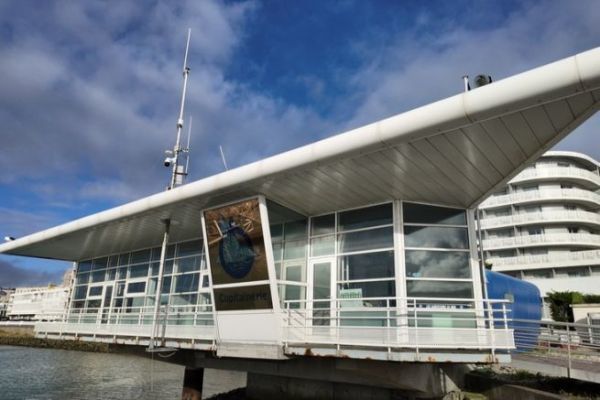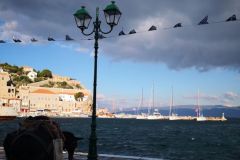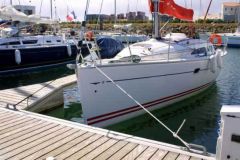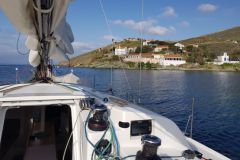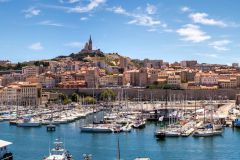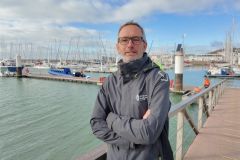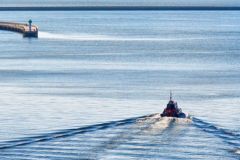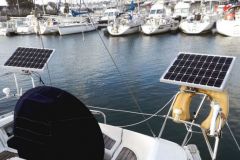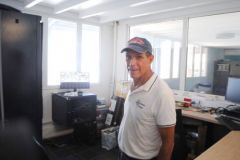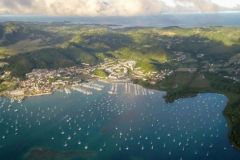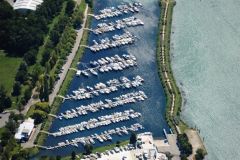What is your relationship with the sea, yachting and the the Seine Bay's regatta DNA
I'm the main harbour master at Le Havre marina and I've been doing this job for 15 years. I'm from Le Havre, so I started out at the CNPH, which later became the SNPH, a local sailing club in Le Havre. I know the Le Havre environment well, the clubs and the local economic fabric. I've also sailed elsewhere, but here's a stretch of water that I like for its various technical aspects: the currents are quite strong, and the cliffs have quite strong site effects. It's a fairly technical stretch of water, which can be rough at times, and there's always a bit of chop in the Baie de Seine. Finally, I appreciate the proximity of England, and its great potential for regattas from Cowes to Dieppe, Le Havre, Dinard, Cherbourg, Deauville...
I sail in IRC and I'm also an OSIRIS delegate. These are gauges I know well, and they evolve over the years. So I'm in a pretty good position to welcome people here at the marina, and guide them if they have a bit of a racing or cruising profile.
It's a year-round sailing area. Today, it's the end of October, and if I look outside, I can see light sailing catamarans passing under the windows. This weekend, there were dinghies, Optimists, and there are regularly 420s, Lasers, 5o5s and Fin boats. The town council wants to boost the town's nautical vitality, so it's important to have an active body of water and to have clubs that drive nautical activity.
Can we present the port, the different basins, the infrastructures?
Le Havre marina has 3 sites:
The main port is open 24 hours a day. It has around 1,150 moorings, with 80 visitor berths. It's at the head of the Seine bay, close to the estuary. We're one of the only ports in the region to be able to enter without tidal constraints between Dieppe and Cherbourg.
In the main harbor, there are slightly more sailboats than powerboats, although the trend is changing slightly.
Annual sailors cruise. They sail to Lower Normandy and Brittany in summer. Some go to England or up north. There's also a sizeable network of regatta sailors.
And then there are a lot of anglers who fish almost all year round. The Baie de Seine, with its current areas, supplies sea bass, mackerel...
The second site, Port Vauban, is a downtown harbor behind a lock. It has 170 berths. It was opened in 2012 and was originally designed to bring some pleasure boating back to the basins and give boaters another alternative. The main port had run out of room for expansion. Port Vauban has breathed new life into the marina and provided us with berths. Of course, it's not as easy to get in and out, since there's a lock in the morning and evening, all year round. But it allows sailors who are preparing a boat for a long voyage, or who want to sell their boat, or who are using their boat less... We also get people back from long voyages. Some of them live aboard before leaving. We also have some students at Sciences Po or ENSM, who live aboard their boat at Port Vauban.
The ESCO area is the third site to be opened in 2014 as a land-based storage and maintenance facility for boats. Previously, boats were landed at the main port. In 2014, due to expansion constraints and a desire to be able to extend a little further, we opened a technical area where there are 3 lifting machines on site. This enables us to land boats up to 30 tons and 6 meters wide. A mobile crane enables us to be quite flexible in terms of handling, for mast rigging, dismasting or small boat landings.
Le Havre's three marina sites are managed from the main harbor office.
How busy is Le Havre marina? What is the occupancy rate by boat category?
In the main port, we are at 100% occupancy. Current demand is concentrated on boats under 7 meters and units over 10-11 meters. These are really the two categories where we have the greatest demand for space. Every year, in the port of Le Havre, we have around 200 cancellations out of a total of 1,300 berths, including the two afloat ports. Inevitably, there's a bit of a wait for annual berths for boats over 11 meters.
But with the two other sites, Port Vauban and the Esco area, we can find intermediate, alternative solutions. In other words, for a boat arriving in October, for example, we can offer to put it ashore until April-May. After that, we might suggest that it goes to Port Vauban. And then, for the summer, July-August, either the boat sails and leaves Le Havre, or we welcome it at the visitor pontoon.
We try to be fairly dynamic when it comes to space management. We can offer places during the summer, as we have customers from Le Havre who go cruising for one or two months.
We're at 100% in the main port and a little less, between 75% and 80%, in Port Vauban. In this downtown port, the average boat size is a little higher, with larger units. We don't have any small boats in Port Vauban.
On the other hand, we have a small hole in the boats between 8 and 10 meters.
I realize that the 8.50-9 meter boat, with a single aft cabin, seems to be an intermediate size that has been of much less interest to yachtsmen in recent years. I see a lot of first-time buyers going straight for a 10-11-meter sailboat. When it comes to powerboats, it's either a small fishing boat or a semi-rigid or open hull. Boats less than 7 meters long. Between the small powerboat and the large sailboat, there's little demand for space.
Do you have any idea of the origin of the boat owners?
Historically, there are two basins in Le Havre's main marina: Anse des Régates and Anse de Joinville. Historically, many people from Le Havre are based in Anse des Régates. These are contracts we've had for 15, 20, 30 years sometimes.
Anse de Joinville, on the other side of the dike, receives a few more small boats, with places for slightly larger cruising boats. In this basin, boaters come from further afield, within a 100 km radius. But we also have customers from Paris. We're only 2 hours by train from Paris. It's very easy to come on Friday evening and go sailing on Saturday and Sunday. For the return journey, there are trains until late on Sunday.
I don't have the exact figures, but I think we're talking about 40% of people who are more than 200 km away.
What about the age of the owners and their means?
The average age of owners is between 60 and 65. I think we were at 63 last year. Surprisingly, though, I've found that since Covid, requests for berths have come from younger boaters.
Among our customers, there are several profiles. There's the retired person who says, now I've got time, I'll be able to buy my own boat, and who opts for a small walk-around fishing boat. Or there are people who already sail and who say to themselves, now's the time, now I have the time, I'll buy a sailboat, I can sail it and maintain it.
But for the past 3 or 4 years, requests for places have also come from young people in their 30s and 40s. On the other hand, this clientele is much more fickle than the "old-timers".
When a customer cancels his subscription, we always try to find out the cause. Why do you cancel your subscription? For many, it's for health reasons, or because they don't use the boat very much. For the younger classes, people in their 30s or 40s, it's often after 3-4 years that they stop sailing or change sailing basin. There's a professional transfer, they stop sailing because they have a new child... The older the person is when they take up their boat, the longer they stay with us. Finally, the contract stays with us for a long time.
For our part, we try to take various actions to give contract holders good reasons to stay.
Exactly what kind of activities do you offer contract holders?
We try to keep our customers loyal. Even if someone wants to change dock, we're happy for them. For example, this morning I was on the phone with someone who has had a berth here for ten years. She's changed boats, and has a lot more time on her hands. If his professional activities are heavy enough for him, they will become available next year. So he's decided to leave his berth in Le Havre and go sailing. It's a good move! We're very happy. And it will leave room for someone else.
We have several types of event. For several years now, we've been organizing rallies. We accompany boaters at least twice a year. The first outing is usually at the start of the season. We organize a rally to Caen, Ouistreham and Deauville. We take care of everything, including the evening barbecue, a boat trip to Caen on the canal with the opening of the bridges, and a small restaurant on Saturday. It's an opportunity to give people a little briefing so that they can get to know each other, to explain the passage of the channel, and to give them an idea of the weather and currents. The aim is to get them to meet other yachtsmen. This early-season rally is aimed more at first-time buyers. The aim is to integrate them, to try and create a little pontoon atmosphere. We even create a WhatsApp group for each pontoon. After that, they have contacts and continue to rub shoulders and even sail together. It works quite well, because this year there were 3 rallies, one to Dieppe, one to England and one to the Scillys. Basically, it's a group of people who met on the first events we did.
In the second rally, which we do at the end of September, beginning of October, we try to go 4-5 days further afield. England, often the Solent, because there's a lot to do in the Solent, and we always enjoy it.
Rallies are the first thing we do to get people out on the water, to give them a good reason to use their boat, and to show them that sailing in a fleet also means sailing safely, sharing experience with people who have more experience. It's very instructive.
We also organize workshops during the winter. Once a month on Friday evenings, we welcome a professional on a different theme each time, with 20 to 25 people in attendance. We don't want too many people to participate. There are different themes: for example, safety at sea with the SNSM, where they tell us about their recovery experiences and how to adapt your boat. Or seamanship with a rigger who explained how to make a splice on hollow braid... We also had a weather theme with a meteorologist. We took part in marine mechanics, with a mechanic who explained how to winterize an engine, with tips on how to easily repair an engine at sea, and what the minimum toolbox should be. We also had the harbor master and a pilot from Le Havre come and explain how they see yachting from their big container ship when they come in, and how we can communicate better. We have different themes throughout the year, from winter to April.
We also organize a day called "Boater's Day", when we hold a whole day of meetings on the Terre-Plein Nord. Many associations come to present their activities. Boating professionals come to exhibit. We also give boaters the opportunity to hold nautical flea markets. There's a concert, food trucks, sailing and kayaking baptisms. It's a day dedicated to meeting and exchanging ideas.
Coming back to the port of call, has Brexit had an impact on port traffic?
The Brexit has had a major impact in terms of transits through Le Havre. Overall, from June to September, over the 4 months, we have nearly 2,000 ships calling at the port. Of these 2,000 boats, half are French. And of the other half, half are foreign, half are Dutch. So we have 25% Dutch visitors. Before the Brexit, the other 25% were almost equally English and Belgian. The year of the Brexit in 2023, we've lost all the English. No more passage! In 2024, we started to see a few English travelers again. But it was pretty minimal. But this year, 2025, the English are back in force. I think that the procedures involved in welcoming non-Schengen citizens at the start put off yachtsmen. It was a real brake for them to come and for us to go. Now, with online forms, the procedure has not been simplified, but it is known, with a process in place. There were so many uncertainties at the beginning, I think people didn't dare sail across the Channel.

 /
/ 